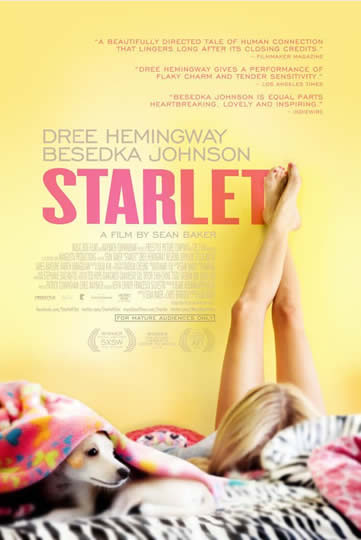 STARLET explores the unlikely friendship between 21 year-‐old aspiring actress Jane (Dree Hemingway) and elderly widow Sadie (Besedka Johnson), after their worlds collide in California’s San Fernando Valley. Jane spends her time getting high with her dysfunctional roommates and taking care of her Chihuahua Starlet, while Sadie passes her days alone, tending to her garden.
STARLET explores the unlikely friendship between 21 year-‐old aspiring actress Jane (Dree Hemingway) and elderly widow Sadie (Besedka Johnson), after their worlds collide in California’s San Fernando Valley. Jane spends her time getting high with her dysfunctional roommates and taking care of her Chihuahua Starlet, while Sadie passes her days alone, tending to her garden.
After a confrontation at a yard sale, Jane finds something unexpected in a relic from Sadie’s past. Her curiosity piqued, she tries to befriend the caustic older woman. Secrets emerge as their relationship grows, revealing that nothing is ever as it seems.
Director Sean Baker continues in the naturalistic style of his previous films, the Spirit Award-‐ nominated PRINCE OF BROADWAY and TAKE OUT, capturing the rhythms of everyday life with a rare authenticity. Featuring exceptional debut performances by Dree Hemingway, (great granddaughter of Ernest and daughter of Mariel) and 85-‐year olf Besedka Johnson, who received a Special Jury Recognition at SxSW, Starlet is at once provocative, haunting, and surprisingly sweet.
Here are our interviews with Sean Baker, director of STARLET and Besedka Johnson, playing Sadie.
Bijan Tehrani: Watching STARTLET reminded me of the French New Wave films and thinking that if the New Wave were happening today, you might be one of the leaders of that movement. STARLET is a very refreshing film. Tell us a little bit about your approach in filmmaking and also if you ever had any interest in the French New Wave?
Sean Baker: Well, thank you for these kind words! Yes, most definitely. It’s funny you mention it because French New Wave I think was my introduction to foreign cinema. I went to NYU, to the School of the Arts. I was actually interested in having a mainstream Hollywood career and around, I think it was Sophomore year, I discovered French New Wave on my own, just by renting a Eric Rohmer film, Claire’s Knee: that was really my introduction and I used it as my launching pad to French cinema. But then I became even more interested in Italian Neorealism and eventually British Social Realism. And it all went back to Cassavetes, because I wasn’t very familiar with American independent work like Cassavetes…
BT: Your style of filmmaking, the way you approach your women in your film is very interesting. It is very different from what we see in mainstream American cinema. It is a much more real, close feeling that you get with the characters when you are watching your films. Tell me a little bit about how you develop characters when you are writing.
SB: We just set out to make them as real as possible because we needed people to connect with them as individuals and then get invested in their relationship. So it wasn’t as if Christopher Bergoch who was the co-writer and I set out to say “we are going to write for women”, we said we’re going to write for real people, real human beings, and that’s how we have a humanized film. The way we would write 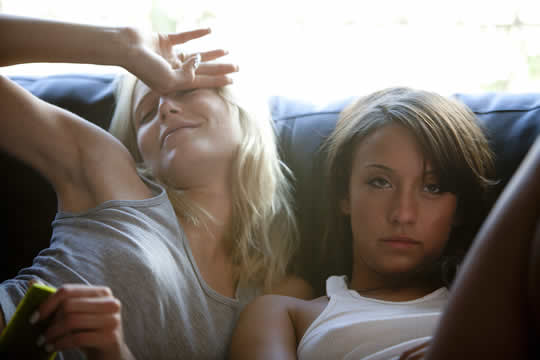 Jane’s reaction to Sadie would be very much the way we would write if it was a young male in that role, a human reaction. So it wasn’t really intentional on our part: we just wanted to write real people, that’s all! We just wanted to capture truth in their characters and I think it’s also a testament to how great they are as actors, how they were able to really just deliver that.
Jane’s reaction to Sadie would be very much the way we would write if it was a young male in that role, a human reaction. So it wasn’t really intentional on our part: we just wanted to write real people, that’s all! We just wanted to capture truth in their characters and I think it’s also a testament to how great they are as actors, how they were able to really just deliver that.
BT: The performance by Dree Hemingway as Jane was shockingly good. It reminded me of, in your film you are giving birth to a new Catherine Deneuve. She’s so talented and I’m sure your way of communicating with her played a part in it. How did you work with her?
SB: She studied acting at the Royal Academy of the Arts so she came to the table already with experience even though this was her lead role debut. So she was very easy to work with and she was willing to improvise. So basically, what I did with this film, which I’ve done with others is tell my actors: here, I’ve written you the dialogue but if you don’t feel like it’s realistic, you can throw our words out the window and we can try something that you come up with. Sometimes this worked and sometimes it didn’t. I worked very closely with her. I didn’t know how much we would be collaborating but within a week or two or maybe during the first week, I was turning to Dree and asking -how do you feel about this? Do you think this works? Does this conversation sound real? And she would give me her opinion and if we weren’t happy, we would work together on coming up with a new line. Some of her improv lines have to be some of my favorite lines in the film. She came up with the line about the Eiffel Tower being in Vegas, that was hers. And also the way she worked with Besedka was very interesting. It was Besedka’s first time in front of the camera but because of Dree’s formal training she was able to sometime guide her, and if there were stumbles she would almost act as my co-director and back everyone up three or four lines and begin again. So Dree is extremely professional. You hear a lot about method acting, where actors are in their characters for months on end while they’re shooting. Dree isn’t like that: she will turn on the moment when you call action and turn off the moment when you yell cut.
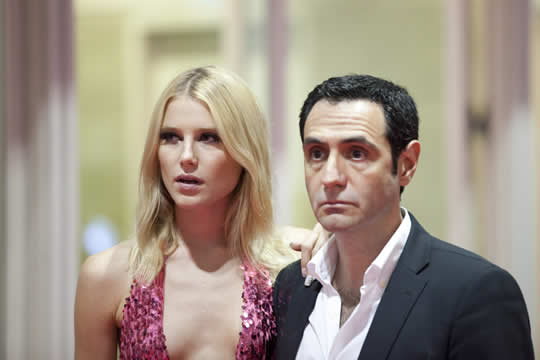 BT: I know that in PRINCE OF BROADWAY, you worked with actors and real people. Here, playing a major part in your film is Besedka Johnson who doesn’t have experience. How was working with her and trusting her with such an important part?
BT: I know that in PRINCE OF BROADWAY, you worked with actors and real people. Here, playing a major part in your film is Besedka Johnson who doesn’t have experience. How was working with her and trusting her with such an important part?
SB: I just knew from our first audition… Of course we had her reading the lines and auditioned her but there was also this sensibility and I just knew that because of this sensibility, we would be able to find truth in her performance. It is sometimes a leap of faith but I found that when you are confident about them as individuals, that leap of faith is not as tough as it might appear to be. And also, with the actors on PRINCE OF BROADWAY, that was their first time acting but, like Besedka, they had aspirations too. I did them a disservice by calling them non-professionals when I was first promoting PRINCE OF BROADWAY but now I like to call actors who haven’t acted before first-time actors. And that’s what Besedka and Dree are but now they are full-fledged actors.
BT: About the style of the film and the work with your director of cinematography, there is a gray tone all throughout that suits the mood of the film. How did you come up with the visual style of the film?
SB: Radium Cheung and I work closely together, we’re always on the same page. We always know what lenses we want to use and we said from the very beginning that we would shoot this film anamorphic widescreen and we used this widescreen aspect ration to really capture the expanse of the San Fernando valley, also allowing the light to really hit into the lens many times throughout the film because that’s how I saw the valley. When I was location-scouting for the few months prior to production, I was driving around the San Fernando valley and I always felt that I was being blinded by the light. So I told that to Radium and he and I tracked down these vintage LOMO lenses, 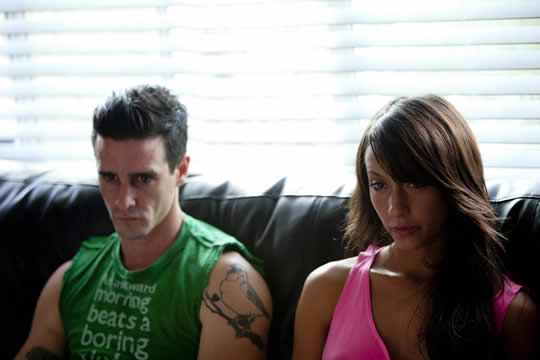 these Russian lenses, in order to capture that feel. And he’s wonderful in terms of framing and lighting. He comes from a gaffing background so his lighting is very subtle. Inside, it’s just enough to see what’s going on but at the same time to make it as realistic as possible. And also what we wanted to do on top of that was combine classic framing and hand-held. So we mixed the styles on a scene by scene basis and we would figure out what was appropriate while we were just about to shoot.
these Russian lenses, in order to capture that feel. And he’s wonderful in terms of framing and lighting. He comes from a gaffing background so his lighting is very subtle. Inside, it’s just enough to see what’s going on but at the same time to make it as realistic as possible. And also what we wanted to do on top of that was combine classic framing and hand-held. So we mixed the styles on a scene by scene basis and we would figure out what was appropriate while we were just about to shoot.
BT: One thing about the screenplay reminds me of a Hitchcock film. The characters have so many different layers and you discover them overtime. Do you do this intentionally?
SB: Yes, most definitely intentionally. As soon as we figured out that Sadie would have a secret, Jane would have a secret, then suddenly it became about using that as a subtext throughout the film. And we wanted to not only have revelations about all the characters, we also wanted to use that in the style of the cutting. For example, you would have showing cut to the music, you would have sections in which we would not reveal things to the audience for a certain amount of time… So using the idea of everybody having secrets and sides of them that we don’t show, we worked that into the style of shooting and editing as well.
BT: You see such a growth in the way that you’ve made your films, from your work in TV to this film STARLET. One can wait to see that you experiment more with the language of film. What are your goals in filmmaking for the future and what are your projects?
SB: There are a few different projects, it depends where the money comes from first. I have actually three features that I’m working on. One is another New York movie. One is a film that actually might take place in Taiwan, that I’m co-directing with Shih-Ching Tsou, who I co-directed TAKE OUT with. And the other one is a small character piece. But with all three of these, one of the things I’ve always tried to do with all these films is I never want to cover ground that’s already been covered. I always want to try something new and I want to bring the audience something fresh.
BT: Thank you for your time.
***
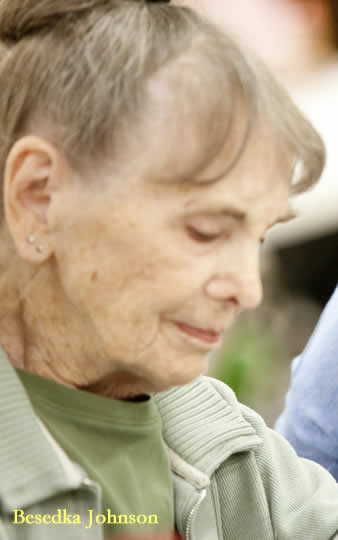 Bijan Tehrani: First of all. Congratulations on your wonderful performance in STARLET.
Bijan Tehrani: First of all. Congratulations on your wonderful performance in STARLET.
Besedka Johnson: Thank you so much!
BT: How were you approached for this part and what was your reaction?
BJ: I go to the YMCA three times a week and this young lady came up to me and said: excuse me, you look like someone that might be perfect for a role in a movie that I’m involved in, I wonder if I could take your picture. My inner voice was saying – what kind of bullshit is this? This is definitely bullshit! But if she wants to take a picture, let her take a picture. So she took a picture and a few minutes later, she came back and said – they liked you, they wanted your phone number and your name, and I thought (bursts out laughing) – well ok, we’ll see! From that time on, somebody called me, gave me the script, I read it. A few days later, I went in for an interview on the script, read the lines and did a little improvisation. And two days later, they called me and said -Besedka, you have the part! And that’s what happened!
BT: Looking at the film, you could never have the slightest idea that you have never been a professional actor. It’s such a perfect part! How did you manage to play the part?
BJ: The director! When he would shoot his scenes, he would always surprise me. We would be in a certain place and he would shoot one scene after another, and the thing that fascinated me is he finally would get what he wanted. Sometimes it would take a while for it to click. For instance, when I lost the dog, I didn’t know where to look. For me to get tearful was easy to bring out because when I watch television and I see how people treat animals and abandon them, I start to cry. I had no problem crying, it just came naturally: just saying goodbye to those sweet animals and how they’re left and ignored. And I just started crying so I could do it every time.
BT: Did the fact that your father was a silent movie actor influence you? Do you remember anything about that time?
BJ: No. I have a picture of him, taken in 1920 and when I look at that picture, the only thing that influences me is – that’s my father and there he is in these chic outfits. And I can’t believe that it’s him but it’s him because I can see his face there! And it surprises me every time I look at it.
BT: Is it true you always wanted to be an actress?
BJ: No. I thought about it when I was little but I was married and had children and I didn’t really have time for that kind of thing. That didn’t make sense.
BT: That makes it more surprising. You have such an amazing interaction with Dree Hemingway. How did this work?
BJ: It was basically magic. The thing that was surprising about her is she was relentless in trying to be my friend and I was fascinated with her ability to continue pursuing trying to keep a friendship with this 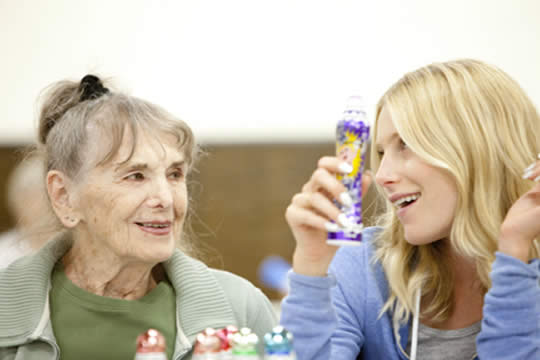 crabby old bitch. And I wondered what possessed her to want to be friend to an old lady. The thing that brought her close to me and closer and closer was when she asked me to care for her dog. When that happened, I felt that I had a friend. She was pursuing me with great vigor and I never could understand why. Beneath that, we all know why: Dree had her own reasons, which was the money she’d found and she realized she wanted to do something nice for the crabby old lady.
crabby old bitch. And I wondered what possessed her to want to be friend to an old lady. The thing that brought her close to me and closer and closer was when she asked me to care for her dog. When that happened, I felt that I had a friend. She was pursuing me with great vigor and I never could understand why. Beneath that, we all know why: Dree had her own reasons, which was the money she’d found and she realized she wanted to do something nice for the crabby old lady.
BT: Now that the movie is done, are you still in touch with Dree?
BJ: No, I saw her today but I haven’t seen her at all, she’d be a great grand-daughter. She’s busy with her own life. But every time I see her, it’s like I find my little child. It’s like your daughter, it’s the same thing, you find someone you can relate to immediately and there it is! And if you never see them again, you have a moment of blessing, of a little joy, of this treasure.
BT: Do you have any actresses that are your idols or who may have influenced you?
BJ: No, the director brought it all out. No one else did.
BT: Are you looking to pursue your acting career?
BJ: If I have another lucky break like I had, that would be fun!
BT: Have you seen the finished film?
BJ: Yes, I’ve seen it three times!
BT: What did you think of the film and your performance?
BJ: I love it; I think it’s absolutely charming. I hope people love it as much as I do!
BT: Thanks a lot for your time and it was a great pleasure talking to you.
BJ: Thank you.

